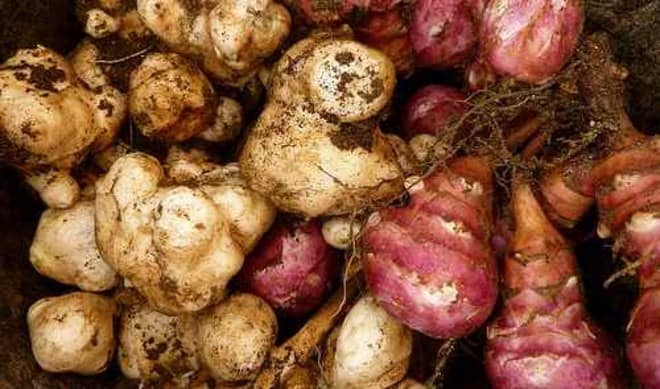Despite its name, the Jerusalem artichoke is not part of the artichoke family, but is actually a member of the sunflower family, Helianthus tuberosus. Its name has no connection to its origin or its genus, and in addition, the Jerusalem artichoke sometimes goes by the name sunroot, sunchoke, or earth apple.
The Jerusalem artichoke is a native of North America, growing wild along the eastern seaboard from Georgia to Nova Scotia. It can be produced throughout the United States, but the plant is better adapted to the northern two-thirds of the country. According to the Sunchoke organization, these tubers were first introduced into Europe by the explorer Samuel de Champlain, after he encountered Native Americans growing them in Cape Cod, Massachusetts in 1605. In his opinion they tasted like artichokes, a name that he carried back to France.
The edible part of the Jerusalem artichoke is its tuber or the swollen end of the underground stem, which has a crisp texture like that of a water chestnut. When cooked, the Jerusalem artichoke has a soft, nutty flavor similar to potatoes.
According to Mother Earth News, the Jerusalem artichoke comes in different strains that vary by skin color, root shape, and maturation time. Some strains include the ‘Red Fuseau’, the ‘Stampede’, the ‘Clearwater, the ‘White Fuseau’, and the ‘Red Rover, just to name a few. The ‘Stampede’ is the early-maturing variety, which develops crisp, round roots quickly enough to be grown in climates with short summers. The ‘Clearwater’ and ‘White Fuseau’ are slower to mature, and have longer roots, which make them easier to scrub and peel. Last, but not least, the red-skinned strains including the ‘Red Fuseau,’ has top-shaped roots with few attached round nodules, making the roots easy to clean.
The Jerusalem artichoke is often planted in the early spring so that the plants have the longest growing season possible to increase the chance of getting big roots. According to Jonathan R. Schultheis, who works with the Extension Horticultural Specialist Department of Horticultural Science in North Carolina State University, the Jerusalem artichoke grows best in well-drained soil with near-neutral pH of about seven. Because this plant can grow up to ten feet tall, it is best to locate the Jerusalem artichoke behind smaller vegetables so they can cast ample afternoon shade.
Jerusalem Artichoke Recipe:
1 head cauliflower, cut into bite-size florets
1 pint Brussels sprouts, cut in half
1/2 pound Jerusalem artichokes, scrubbed and cut into 1-inch dice
Extra-virgin olive oil
Salt
1/4 cup chopped chives
Directions
Preheat the oven to 375 degrees Farenheit.
In a large bowl, combine all the vegetables, coat with olive oil and season generously with salt.
Spread the vegetables on a sheet tray in an even layer, don’t pile them up. The vegetables don’t need to be spread out but they need to be pretty much in a single even layer. If this is not the case, use two trays.
Put the vegetables in the preheated oven, 15 minutes into the cooking process, stir the vegetables so they have the chance to brown all over, and rotate the tray to insure even cooking. Repeat this process after another 15 minutes. Roast the vegetables for an additional 15 to 20 minutes, or until the vegetables are roasty brown and should smell almost like popcorn! Check for doneness. This means taste some! If they aren’t very roasty brown, let them go for another few minutes until they are. Season with salt, if needed. Garnish with chives and serve immediately!















